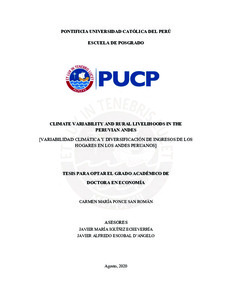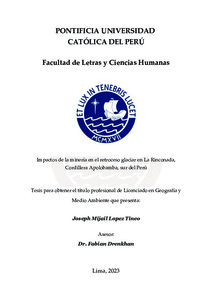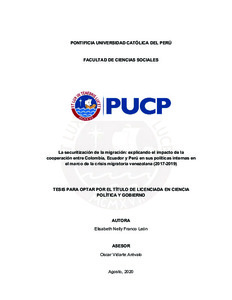Climate variability and rural livelihoods in the peruvian Andes : Variabilidad climática y diversificación de ingresos de los hogares en los Andes peruanos
Abstract
This thesis aims to understand some of the effects of changes in intra-seasonal climate variability
on household livelihoods in the Peruvian Andes. Concerns about the effects of climate change on
the sustainability of Andean agricultural systems and, in general, concerns about the ability of rural
households to adapt to increasing climate uncertainty motivate this thesis. The first study focuses
on household decisions over crop portfolio diversification as a response to increasing climate
variability. The study investigates whether Andean farmers respond by increasing crop diversity
(measured by intercropping and crop diversification indices) or by switching to crops that better
tolerate diverse environmental conditions. Based on fixed effects models that use a district panel
of 1994 and 2012 agrarian censuses, the study finds that households in colder areas (<11˚C during
the crop growing season) adapt to increases in climate variability by concentrating their portfolio
into more tolerant crops and reducing intercropping (a practice potentially efficient at controlling
pest and disease). This effect is especially strong in the Southern region (more indigenous, less
integrated to markets). Taking a broader approach, the second study focuses on Andean rural
households in general, investigating whether households adapt to increasing climate variability by
concentrating more into non-farm income generating activities (relative to farm activities), and
whether spatially distant family networks facilitate this adaptive strategy. Six economic outcomes
are modeled in this study: non-farm income shares, non-farm working hours share, farm and nonfarm
income levels, and farm and non-farm working hours. Based on generalized linear models
that use household information representative of rural provinces of the Andean region, the study
finds that households adapt differently across the region. While households in the colder areas of
the Central and Northern Andes (below 13˚C during the crop growing season) tend to increase
non-farm income as climate variability increases, households in the South show no discernible
response. The study results suggest that spatially distant family networks facilitate non-farm
opportunities to households facing increasing temperature variability in the Central and Southern
Andes. This thesis complements previous studies by providing robust and regionally representative
evidence on households’ nonlinear response to climate variability. Furthermore, given that Andean
households received little-to-no help to adapt to climate change during the period under analysis,
this study informs about household autonomous adaptation to climate change and raises concerns
on current adaptation responses that may hamper the sustainability of Andean household
livelihoods in the face of climate change.
Temas
Familias rurales--Andes, Región (Perú)
Sistemas agrícolas--Andes, Región (Perú)
Cambios climáticos--Andes, Región (Perú)
Sistemas agrícolas--Andes, Región (Perú)
Cambios climáticos--Andes, Región (Perú)
Para optar el título de
Doctor en Economía
Collections
The following license files are associated with this item:
Related items
Showing items related by title, author, creator and subject.
-
Impactos de la minería en el retroceso glaciar en La Rinconada, Cordillera Apolobamba, sur del Perú
Lopez Tineo, Joseph Mijail (Pontificia Universidad Católica del PerúPE, 2023-12-15)A pesar del creciente número de estudios sobre el efecto del cambio climático en los glaciares peruanos y su impacto en la seguridad hídrica, existe una brecha de conocimiento sobre cómo la minería afecta a los glaciares. ... -
The role of organic carbon and arsenic in the formation of sediment-hosted gold deposits: A case study of the Shahuindo and Algamarca epithermal deposits, Peru
Galdos Postigo, Renzo Andres (Pontificia Universidad Católica del PerúPE, 2024-05-09)The goal of this study is to determine the source of gold and the role played by organic carbon and arsenic in the formation of sediment-hosted gold deposits. The effect of and link between these two ubiquitous ingredients ... -
La securitización de la migración: explicando el impacto de la cooperación entre Colombia, Ecuador y Perú en sus políticas internas en el marco de la crisis migratoria venezolana (2017-2019)
Franco León, Elisabeth Nelly (Pontificia Universidad Católica del PerúPE, 2021-01-15)Colombia, Ecuador y Perú son los tres países que más migrantes venezolanos han recibido desde el 2016, año en el que el ritmo de salida de Venezuela creció exponencialmente. De los 3.9 millones de migrantes y refugiados ...









